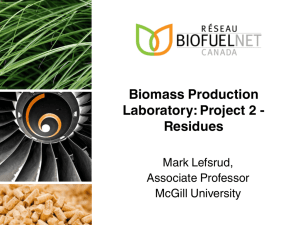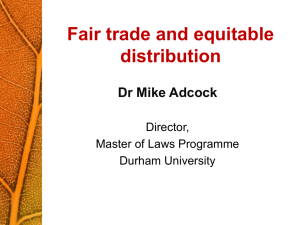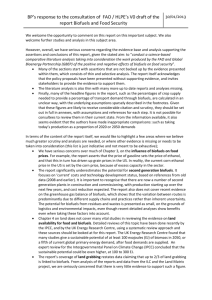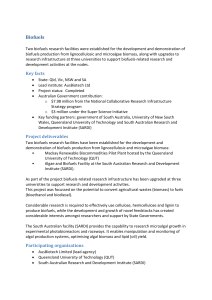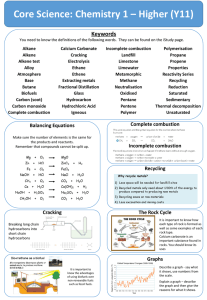GCEP Progress Report Technology Potential of Biofuels: Feasibility Assessment
advertisement
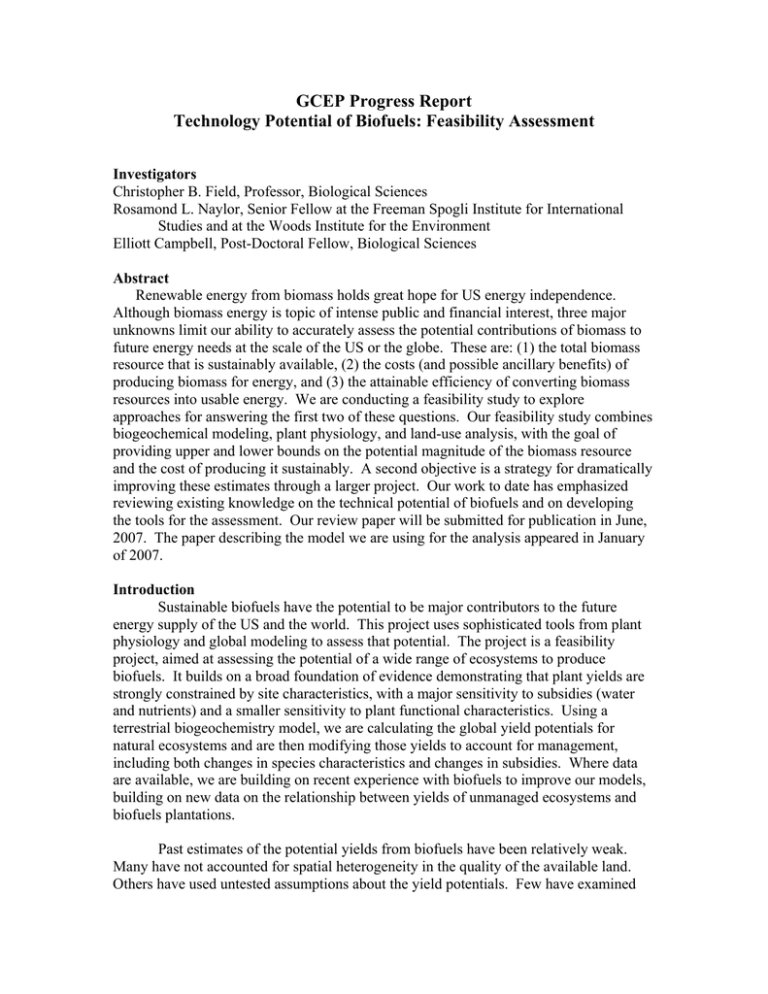
GCEP Progress Report Technology Potential of Biofuels: Feasibility Assessment Investigators Christopher B. Field, Professor, Biological Sciences Rosamond L. Naylor, Senior Fellow at the Freeman Spogli Institute for International Studies and at the Woods Institute for the Environment Elliott Campbell, Post-Doctoral Fellow, Biological Sciences Abstract Renewable energy from biomass holds great hope for US energy independence. Although biomass energy is topic of intense public and financial interest, three major unknowns limit our ability to accurately assess the potential contributions of biomass to future energy needs at the scale of the US or the globe. These are: (1) the total biomass resource that is sustainably available, (2) the costs (and possible ancillary benefits) of producing biomass for energy, and (3) the attainable efficiency of converting biomass resources into usable energy. We are conducting a feasibility study to explore approaches for answering the first two of these questions. Our feasibility study combines biogeochemical modeling, plant physiology, and land-use analysis, with the goal of providing upper and lower bounds on the potential magnitude of the biomass resource and the cost of producing it sustainably. A second objective is a strategy for dramatically improving these estimates through a larger project. Our work to date has emphasized reviewing existing knowledge on the technical potential of biofuels and on developing the tools for the assessment. Our review paper will be submitted for publication in June, 2007. The paper describing the model we are using for the analysis appeared in January of 2007. Introduction Sustainable biofuels have the potential to be major contributors to the future energy supply of the US and the world. This project uses sophisticated tools from plant physiology and global modeling to assess that potential. The project is a feasibility project, aimed at assessing the potential of a wide range of ecosystems to produce biofuels. It builds on a broad foundation of evidence demonstrating that plant yields are strongly constrained by site characteristics, with a major sensitivity to subsidies (water and nutrients) and a smaller sensitivity to plant functional characteristics. Using a terrestrial biogeochemistry model, we are calculating the global yield potentials for natural ecosystems and are then modifying those yields to account for management, including both changes in species characteristics and changes in subsidies. Where data are available, we are building on recent experience with biofuels to improve our models, building on new data on the relationship between yields of unmanaged ecosystems and biofuels plantations. Past estimates of the potential yields from biofuels have been relatively weak. Many have not accounted for spatial heterogeneity in the quality of the available land. Others have used untested assumptions about the yield potentials. Few have examined the carbon-cycle consequences of removing pre-existing vegetation. Our project addresses all three of these issues. Progress Work to date has focused on developing the modeling tools and databases for the global scale analysis of biofuels potential. A second effort has focused on reviewing existing information on biofuels yield potential and environmental impact. As a consequence of the review, much of our attention is now being focused on understanding the carbon-cycle impacts of biofuels in locations where fuel crops are replacing forest, a case common across South Asia. The primary modeling tool for this project is a newly developed terrestrial biogeochemistry model that explicitly treat nutrient limitation (Wang et al., 2007). In the past, many models of plant growth tended to be overly optimistic, because they failed to account for the limitations to plant growth imposed by limited nutrient availability. Our new model, CASA-CNP (figure 1) builds on a widely used earlier model from the Field lab. The explicit treatment of nutrient limitation makes the model much better suited than its predecessors to questions of biofuels potential, as many potential biofuels sites are nutrient limited, sometimes profoundly. The CASA-CNP model also provides a powerful way to assess impacts of fertilizer addition, as its explicit treatment of nitrogenphosphorus interactions allows addition of one element to result in variation in the availability of the other. Figure 1: A schematic diagram of the model. The grey square box represents the spatial domain of a terrestrial ecosystem, within which plant pools (in light grey) and litter and soil pools (in dark grey) are included. Exchanges with the atmosphere, hydrosphere, and geosphere are indicated by arrows. Biochemical phosphorus mineralization rate (FPtase) represents the flow of organic P from litter or soil organic matter pool to the labile P pool. Our review has focused on understanding the factors that limit plant growth as a function of climate, soils, and species characteristics. We have also focused on understanding the relationship between plant growth in managed agricultural systems and unmanaged ecosystems in the same habitat. Surprisingly, we find that total plant growth or net primary production is typically greater in unmanaged than in managed ecosystems. In fact, it is only with substantial subsidies of water and/or nutrients that agricultural ecosystems approach the net primary production of unmanaged ecosystems in the same region. The main exception to this pattern comes from tree species subjected to intensive selection or other forms of improvement. We are using the historical record of yield trends in trees and crops as constraints for projecting future yields. Future Plans Global scale modeling of potential biofuels yields is getting underway. A new postdoc (Elliott Campbell) is in the process of learning the tools and fine tuning the approach. Simulations in the planning stage will address (1) potential biofuels yields of the world’s marginal and abandoned farmland (2) potential biofuels yields under several scenarios of converting farmland or wild lands to biofuels production, and (3) carboncycle consequences of converting forests to biofuels production. We are also exploring ways to explicitly study the trade-offs (or lack of trade-offs) between food, forests, and biofuels in a future, expanded, project. Publications 1 Wang, Y.-P., B. Houlton, and C. B. Field, 2007: A model of biogeochemical cycles of carbon, nitrogen and phosphorus including symbiotic nitrogen fixation and phosphatase production. Global Biogeochem Cycles, 21, doi:10.1029/2006GB002797. References 1 Wang, Y.-P., B. Houlton, and C. B. Field, 2007: A model of biogeochemical cycles of carbon, nitrogen and phosphorus including symbiotic nitrogen fixation and phosphatase production. Global Biogeochem Cycles, 21, doi:10.1029/2006GB002797. Contacts Christopher B. Field, cfield@globalecology.stanford.edu Rosamond L. Naylor, roz@stanford.edu Elliott Campbell, ecampbell@globalecology.stanford.edu
